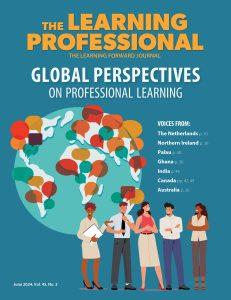Almost 1 in 10 students in the U.S. is identified as an English learner, also known as a multilingual learner (MLL) or emergent bilingual. Multilingual learners are extremely diverse, speaking more than 400 languages, learning two or several languages, and attending all kinds of school districts (urban, suburban, exurban, and rural) (NCES, 2020). But they have one thing in common: they are learning English while simultaneously learning academic content.
''Multilingualism is an asset that educators should honor, integrate, and celebrate in the classroom.'' @SarahOttow Share on XMultilingualism is an asset that educators should honor, integrate, and celebrate in the classroom. But we must also acknowledge that these students face challenges that have been exacerbated by the COVID-19 pandemic. Over the past year, we have learned much about the challenges and resilience of multilingual students. We can use those lessons to set students up for success as they finish out the school year remotely or transition back to in-person instruction.
Here are three ways for educators to focus their own learning about and support for multilingual students and communities that are particularly relevant right now.
Here are three ways for educators to focus their own learning about & support for multilingual students & communities. @SarahOttow Share on XSharpen your equity lens
If equity is our mission as educators, then we need to actively support content and academic language learning – not be limited to remediation – so that all multilingual learners can reach their educational potential. Here are some tips I recommend to make learning accessible to and rigorous for multilingual learners:
- Teach your students, not just the content. Learning happens when the student connects with the content so we need to start with our students, getting to know their strengths, their backgrounds, their interests.
- Remember that academic language is more than just vocabulary. Instructional materials typically feature technical vocabulary but don’t make visible other crucial aspects of functional academic language like how to ask questions and respond based on the genre or language demands.
- Ensure students are reading, writing, listening and speaking in every lesson. We learn language by using it, not just listening to it, so make sure students in all classrooms get to practice oracy (speaking and listening) plus literacy (writing and reading) throughout their school day.
- Build metacognition and metalinguistic awareness for English learners. Metacognition is when we help students think about thinking whereas metalinguistic awareness is when we help students think about language — both are important for learning the language of any content area.
Read more about these tips here.
Here are some tips @SarahOttow recommends to make learning accessible to and rigorous for multilingual learners. Share on XIn your professional learning plan, build in time for your school community to create a shared vision of equity. What does equity mean to us? How do we define it? What does it look like in classrooms? Make sure you include those students and families on the margins as part of the vision of equity so that all voices are heard. Then, teams can determine what specific data will be collected during walkthroughs and observations so that everyone is on the same page about how this vision can manifest in classrooms. For example, if we want to see evidence of students’ backgrounds and prior experiences visible, we may expect to see meaningful responses visible as student work posted or through ongoing academic conversations that bring in students’ perspectives on the topic at hand.
Understand the intersectionality of race and language
Over 90% of multilingual learners are students of color (NCES, 2019), and during this coronavirus pandemic, BIPOC (Black, Indigenous and People of Color) have been disproportionately affected by the virus, as well as other symptoms of systemic racism including lack of access to health care, increased unemployment, and pervasive poverty. In fact, Latino children are eight times and Black children are five times more likely than their white peers to be hospitalized with COVID-19 (CDC, 2021). As educators we need to look inward to unpack our own biases as social agents in positions of leadership and/or through our policies and pedagogy. We need to examine who our students are, across all identity groups – race, ethnicity, class, language, religious affiliation, gender identity, ability, immigration status – and understand the intersectionality of belonging to multiple identity groups. I refer to this increasing diversity in demographics as the “new mainstream” and I encourage educators to not make assumptions about their students but really get to know them.
For example, in looking closely at one’s multilingual learner population, you might find that what seems like a “Latino/Latinx” group is actually made up of some Black Caribbean youth, some indigenous groups from various geographical locations in Central America, and perhaps many US-born groups. If you’re not sure what to call certain groups, when in doubt, ask! Centering schools around our students and those who have been historically marginalized is a big part of an equity-based mindset and corresponding set of practices that can, and should, be adopted. Read more about an equity-based approach I propose here.
Make a comprehensive data dive part of your professional learning so that educators are going beyond testing data to look at demographic data, including information about students’ race, ethnicity, class, special education status, EL status, and gender identity. Moreover, by bringing in perceptual data like engagement surveys and focus groups, strengths and needs may be further revealed to guide educators in a shared effort of anti-bias, anti-racist, and more inclusive, transformational schooling.
Use your voice to advocate for civil rights
The language learner group as a whole currently faces serious civil rights issues around mandated English proficiency tests. All U.S. public school students – including students identified as English learners – are required to take federally mandated content assessments annually (i.e., state tests). English learners are also required to take annual tests of their English language proficiency. The most prominent English language proficiency test in the United States, used across 40 states and territories, is the WIDA ACCESS test. This test, which takes up to four hours to complete over multiple sessions, is not available digitally. Even though many multilingual learners have been participating in remote learning, educators are being asked to have students come to school to take this English proficiency test, potentially increasing their risk of COVID.
Upholding this testing mandate during the pandemic is a civil rights issue – one that English Learner families may not have the affordances to fight for, because they may lack the language skills needed to advocate for themselves and/ or may not have comfort with navigating their own rights in this country. A coalition of groups including the National Association for Bilingual Education and the Lawyers’ Committee for Civil Rights Under Law call this mandate “concerning” and together they urge President Biden and his team to postpone these tests or make them optional altogether. While measuring English proficiency is an important marker of growth, the coalition asserts that “EL students and their families should not be forced into schools and expose themselves to unnecessary risks during these unprecedented times” (Wong, 2021).
One way to address this issue, and to serve multilingual students better in general, is for educators to use multiple measures of language skills. As a specialist focused on equity, language and literacy in schools, I have been writing and speaking for years on the need to build in multiple measures in an ongoing way for this group of students. Too much emphasis is put on one testing “snapshot” when we know that language is dynamic, fluid, and changes greatly day-to-day based on sociocultural context. As one leader I work with says, “We need to continually ask who the children behind the numbers are.” To put so much pressure and reporting mainly on this one test is a major disservice to students.
Instead, we need more of a “photo album” approach focused on growth, not just proficiency, infusing curriculum-based academic language objectives and student goals that drive meaningful learning. Read about an approach for balanced EL assessment here.
I recommend that schools inform all staff on the legal rights that multilingual families and students have so that every educator understands the imperative for equitable education, not just the EL department. This includes knowing families’ rights regarding access to information in their home languages preferably through certified interpreters and professional translations, plus the value of data from the annual language proficiency assessments to drive instruction.
Don’t wait to build equity for multilingual students
We can’t wait to attend to equity for English learner students. We need to change the way we teach, the way we test, and the way we lead, and we need to do it now. When educators work together to build knowledge and capacity, we all grow and become better positioned to support our students and the whole community.
The new US Secretary of Education, Miguel Cardona, has expressed that it is his priority to ensure that all students’ civil rights are upheld. As a second language learner himself, he has shared how bilingual and bicultural identity is “as American as apple pie.” Like me, he is the first in his family to graduate from college, and he is an adamant advocate for those who are the most vulnerable in our schools (Turner, 2021). This kind of global and equity-based perspective at the very top of public education is exactly what we need right now. Educators at all levels can do their part by learning how to support multilinguals during one of the toughest periods our country has experienced.
References:
CDC. (2021, April). Risk for COVID-19 Infection, Hospitalization, and Death By Race/Ethnicity. Available at https://www.cdc.gov/coronavirus/2019-ncov/covid-data/investigations-discovery/hospitalization-death-by-race-ethnicity.html
NCES. (2020, May). English Language Learners in Public Schools. Available at https://nces.ed.gov/programs/coe/indicator_cgf.asp
NCES. (2019, February). Indicator 8: English Language Learners in Public Schools. Available at https://nces.ed.gov/programs/raceindicators/indicator_RBC.asp#:~:text=public%20school%20enrollment.-,Over%20three%2Dquarters%20of%20ELL%20students%20were%20Hispanic%20
Turner, C. (2021, February 2). Education Pick Miguel Cardona Is New To Washington – But Not To Classrooms. NPR. Available at https://www.npr.org/2021/02/02/962050863/education-pick-miguel-cardona-is-new-to-washington-but-not-to-classrooms
Wong, A. (2021). Despite COVID-19, Standardized Testing May Force English Learners Back to School Campuses, USA Today. Available at https://eu.usatoday.com/story/news/education/2021/01/20/english-learners-could-forced-take-person-tests-despite-covid/4183818001/






